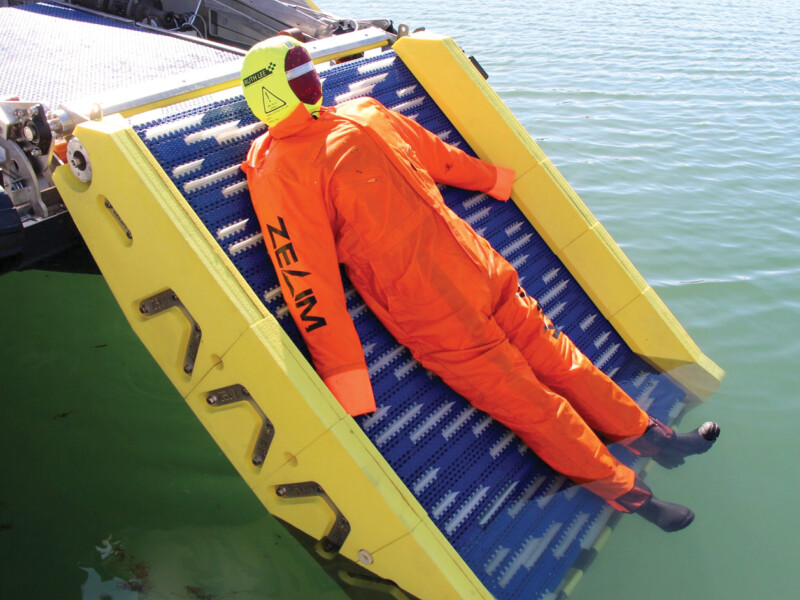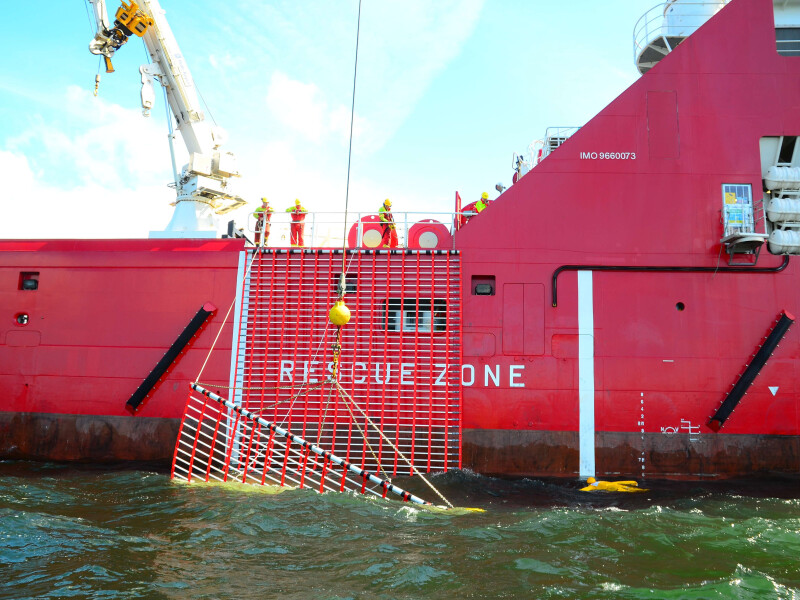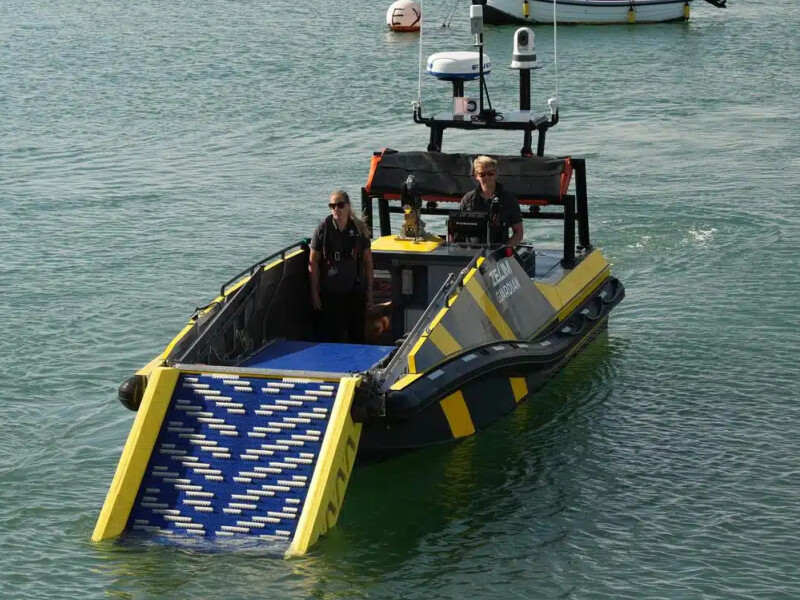Imagine you’re a crewmember on a working vessel and one of your crewmates falls overboard. Instantly, you jump into action, grabbing a specially-made, lightweight pole with an ergonomically-designed hook. Even if the person in the water is unconscious, the pole gently grabs the individual. In seconds, you guide the victim to the bow of the boat, where a specially-designed conveyor belt hauls the person safely back on deck.
Imagine no more. A Scottish company, Zelim, has developed the Swift man-overboard (MOB) recovery conveyor belt that lowers into the water with special fins that pull a victim aboard.
“When you’re in a time-critical environment, we’ve been proven in trials to be at least 20 times quicker than the competition,” said Sam Mayall, CEO and founder of Zelim. “Finding someone in the water is a game of chance. And rescuing people once you have them alongside, it’s difficult to get them back on board.”
Zelim is among a handful of companies that have been working to improve the equipment that vessels and offshore platforms use to recover MOB victims as safely and as quickly as possible.

FIRSTHAND EXPERIENCE
Mayall previously worked on deck as a professional mariner. He has seen friends go overboard — some were injured, others killed.
“The key theme through the instances was the time taken to find people and the time then taken to rescue them,” said Mayall.
And that was when a rescue was attempted. In other situations, personnel went overboard in conditions that were deemed too dangerous for the crew to launch a fast-rescue craft.
“Everyone assumes you put your hero capes on, jump in the rescue boat, and everything will be fine,” said Mayall. “The reality is that a rescue boat is quite small and it’s quite a big ocean, so there’s a risk putting three guys in a boat to save one.”
Mayall and his partners, Chief Operating Officer Stewart Gregory and Chief Technical Officer Doug Lothian, started Zelim in 2017 with a plan for an uncrewed rescue boat with an integrated conveyor belt. “Unmanned rescue was the original idea on the back of the napkin in the pub after a day on the water,” said Mayall.
After investors backed Zelim with $10 million, the company developed the Swift MOB recovery unit. What makes the Swift so effective is that the end of it floats, so the conveyor belt stays at the same point in the water relative to the person being guided onto it. It’s made from an aluminum frame with foam padding. The belt is powered by a 240-volt motor, and the unit can be raised and lowered from a vessel with a winch or manually.
The standard size Swift unit measures about 6' and is designed for a vessel with a freeboard of about 3'3". The company can make larger custom units. Retail prices start at $39,000. The Swift unit comes with a lightweight, telescoping carbon-fiber pole with an ergonomically designed hook that makes it easier to guide a victim onto the conveyor.
Mayall said the company developed four prototypes before getting approval from the coast guards in the U.S., U.K., and Canada, as well as other rescue agencies.
The company name, Zelim, is short for Zero Limits, and the business has about 40 employees at its headquarters in Edinburgh, Scotland.
In addition to the Swift conveyor, Zelim offers ZOE Intelligent Detection, an AI-powered system that pairs cameras from Teledyne FLIR and other suppliers with proprietary software written by Zelim to track and find crew who fall overboard. ZOE, which stands for Zelon Optical Enhancement, can be used on any large vessel where the crew wants more enhanced vision of its surroundings. An upgraded version includes additional cameras for tracking someone who falls overboard.
Zelim also offers the Guardian uncrewed vessel, which is launched from a host vessel and operated with a remote to rescue personnel from the water. It uses ZOE technology to track the person and then the Swift conveyor to safely bring the victim aboard the host vessel. It has a traditional deep-V hull with a 400-hp electric inboard motor that powers a waterjet, eliminating the possibility of a propeller strike. Mayall said the boat, which is still in certification testing, will be priced similarly to other fast-rescue boats.

EXPANDED REACH
Founded in 1979, Norwegian company Dacon began as a maritime training provider. Today, it operates three divisions, including one dedicated to marine rescue equipment that offers a series of rescue nets.
For larger vessels and offshore facilities like oil platforms equipped with a crane or davit, the Dacon Rescue Scoop stows along a bulwark or railing and can be used as a scrambling net. As the name implies, it’s a big scoop made of netting that lowers into the water and gently retrieves MOB victims.
The product is designed to recover the person quickly as well as keep the victim horizontal, which Dacon says is safer. “All the products we deal with are made with keeping a person horizontal,” said Kim Vågeskar, Dacon’s division manager for rescue equipment.
Vågeskar said that the Rescue Scoop has been the company’s most popular product, with more than 900 sold. About 10 years ago, when there was a downturn in offshore oil production, the company shifted gears to focus more on manual rescue nets.
The Dacon Rescue Frame has telescoping fiberglass poles and webbing so it can be formed into a cradle that keeps the victim horizontal during a rescue. It’s foldable, so it takes up little space, and it doubles as a climbing net.
“We decided to put more focus on that, and now we sell it to just about anything that floats,” said Vågeskar. “We went from selling about 100 of those a year to now we sell more than 500 each year, plus a couple hundred nets of other varieties like scrambling nets and power-assisted nets.” Prices range from $1,200 to about $5,000 for manual nets, depending on the size. The most popular size is just under 6' long.




